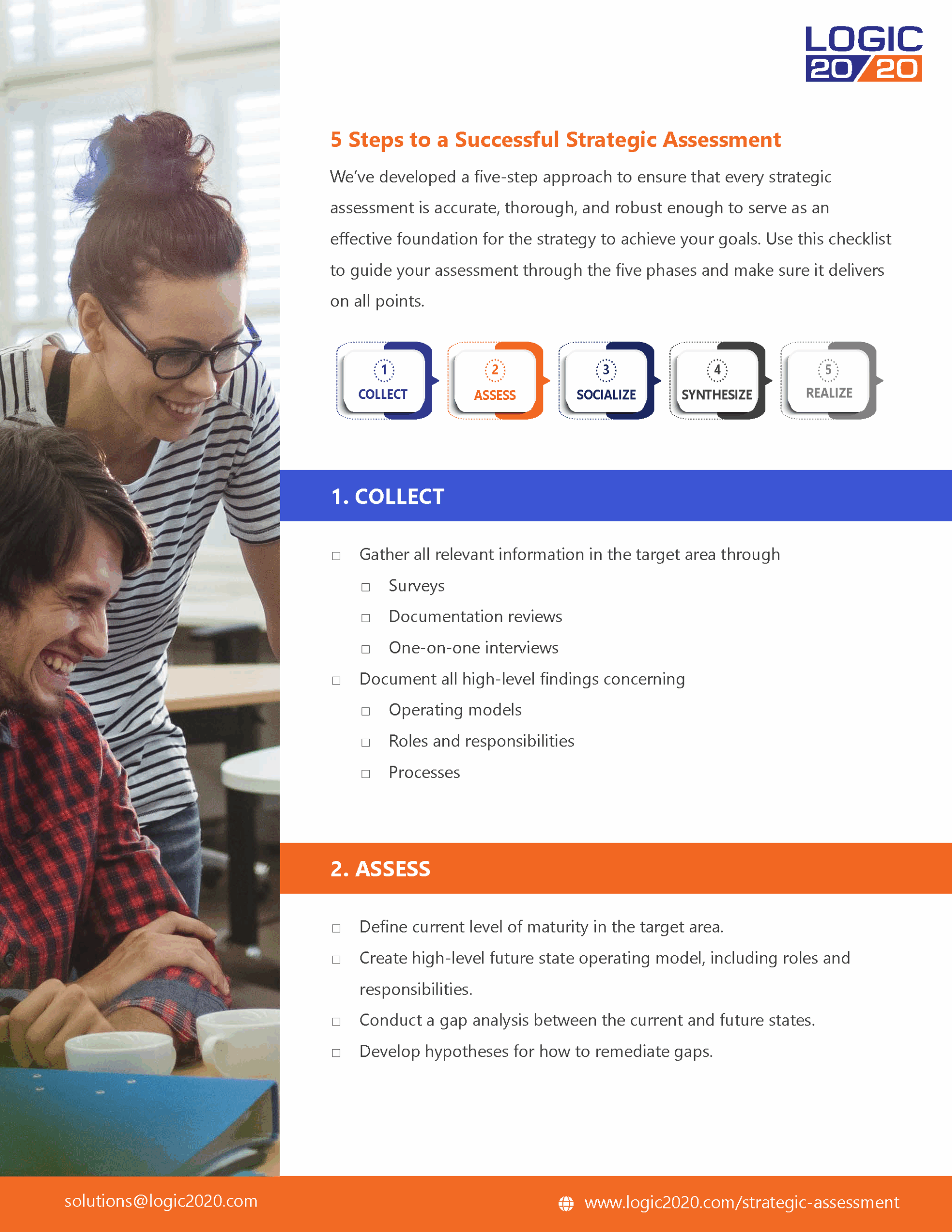7-minute read
Originally published October 2021. Updated June 2025.
Quick summary: Organizations embarking on new initiatives must start with a thorough current state assessment, which is akin to finding the “you are here” point on a map, to effectively chart their path to success.
“You are here.” If you’ve ever had to navigate your way through an airport or convention center, finding these three words on a map are the first step in getting where you want to go.
When organizations identify a goal—whether that’s aligning with a new data privacy law, integrating a recent acquisition, or moving to a new operating model—the journey towards that goal starts with the same step as the airport scenario: figuring out where they are today. We call this step the current state assessment, and if it sounds like simple common sense, it is. But you’d be surprised how often businesses get it wrong … or leapfrog right past it.
When a business approaches current state assessments from a holistic perspective, evaluating every relevant aspect of their present situation—the good, the bad, and the ugly—they have a solid foundation for the strategy that will drive them towards their goal. This “as-is” current state analysis identifies strengths and weaknesses in the effort to improve efficiency and profitability, emphasizing the focus on present operations rather than future objectives. Along the way, they often learn some surprising insights about root causes of the issues they’re trying to address.
With a clear understanding of the current state, leaders can outline actionable steps to achieve their desired objectives. Today, we’ll discuss how to do these assessments the right way.
What is a current state analysis?
A current state analysis (or current state assessment) is a business process that evaluates the current state of an organizational issue to create an accurate starting point from which to build your roadmap. These analyses can be done anywhere in the organization from customer-facing operations to back-end operations.
Download the Current State Analysis Checklist
Accelerate your strategic initiatives with an actionable checklist designed to assess your organization’s current state across five essential dimensions.

Why are current state analyses necessary?
Whether your goal is finding an airport gate or migrating your organization to a new software platform, the first task is the same: finding the “you are here” point. Knowing where you are today gives you a clear picture of how far away your goal is and lets you begin planning a path to get there—without unnecessary detours that can waste time and resources.
In many organizations, there’s a strong temptation to skip this important step and move straight into planning solutions. But without a current state assessment, they risk misdiagnosing the root cause of the problem and heading down a wrong path, only to later discover their error and have to retreat back to Square One. In addition, the oversight of one or more critical issues could lead to designating a future state that has little if any chance of success.
For example, if the problem is sagging revenues, it may be tempting to launch a comprehensive strategy for increasing sales, involving everything from hiring additional sales reps to increasing incentive bonuses. But if the root cause of the revenue drop is actually a recent price increase that makes the product less competitive—a fact that could have come to light in a current state assessment—achieving the goal requires a very different strategy.
While the need for a current state assessment may seem like a no-brainer, we often hear from clients about consulting firms who bring in cookie-cutter solutions without bothering to evaluate the problem at hand. When we work with clients, we take the time to build a 360-degree picture of the present situation, which enables us to identify the issues with the greatest impact on ROI and assign them top priority when we build the strategy. To some our approach may seem “old school,” but time and time again it’s proven to be an investment that pays off many times over.
Questions about current state assessments? We can help.
Where can a current state analysis go wrong?
In addition to skipping them entirely, a host of other errors around current state assessments can delay or even derail progress towards a strategic objective. Here are a few of the biggest hazards to watch out for.
Settling for a superficial understanding
Business problems are rarely simple, so giving short shrift to the current state assessment is likely to lead to wasted time and resources down the road. Reviewing a few reports and talking to a couple of executives will rarely yield the kind of insights needed to determine and implement a course of action with confidence.
Ignoring cultural aspects
Another potential pitfall to avoid is relying solely on quantitative data or on the high-level perspectives of department leaders or process owners. Solving a problem or pursuing a goal involves change, and every organizational change involves people at multiple levels and in multiple roles. Understanding the cultural aspects of a problem is key to building a strategy that everyone can support.
For example, if the business is addressing low adoption rates for a new software application, one of the key causes could be insufficient or poorly designed training for the desired users—a factor that might only be uncovered by involving the users themselves in the assessment process. Bringing users into the process at the assessment phase helps ensure a solution that works at all levels.
Over-reliance on surveys
Surveys are simple, easy to create, and capable of collecting data from hundreds of individuals with relatively little effort. They do not, however, provide all necessary information to plan an effective strategic roadmap towards a goal, and they lack the personal connection needed to give stakeholders a sense of ownership. When we do a current state assessment, we conduct personal interviews with stakeholders at all levels (in person or virtually) to gain a thorough understanding of their perspectives on the issue, their concerns, and what they need from the solution—insights that surveys alone can’t deliver.
5 steps to a successful current state analysis
We’ve developed a five-step approach to ensure that every assessment we conduct for a client is accurate, thorough, and robust enough to serve as an effective foundation for the project. Evaluating processes across the entire organization is crucial to identify inefficiencies and areas for improvement comprehensively. If you’re looking for a current state analysis template, this is a great place to start.
1. Collect
First we collect all relevant information about the issue via surveys, documentation reviews, and interviews with stakeholders at all levels. Then we document all our findings regarding operating models, processes, and high-level roles and responsibilities.
2. Assess
In this phase we create a high-level operating model of the desired future state, including roles and responsibilities, conduct a gap analysis between current state and future state, and develop a hypothesis for remediating the gaps.
3. Socialize
Now it’s time to bring in our stakeholders, share what we’ve learned, identify strengths, and collaborate on next steps. We conduct meetings with core stakeholders where we report our findings and hypotheses from Steps 1 and 2. We then review the proposed operating model, incorporate key changes based on stakeholder feedback, and finalize for roadmap planning.
4. Synthesize
Here’s where we refine our proposed solutions and recommendations. In this step we also do something that often surprises our clients: we expand on our recommendations to include practical to-do items and best practices. This ensures that the client would be able to drive actions to achieve the desired results on their own if they choose to do so.
5. Realize
We wrap up the assessment process by creating next steps and building a roadmap encompassing people, process, and technology to realize the enhancements we identified in our recommendations.

Case study: migrating to a product-focused operating model
Recently a client came to us for help in transitioning to a product-focused business operating model. Specifically, they requested a current state assessment to measure gaps within their existing revenue operations model to better align product management throughout their organization. In our initial discussions with the client, we identified three opportunities for improvement:
- Identify the critical path for agile product management adoption and address key blockers to drive acceleration.
- Enable leadership and business teams with actionable insights for integrating product management and development best practices across the organization.
- Maximize customer value and position the client as a leader in the market.
Our approach encompassed the five stages described above, and upon completion, the client had a detailed roadmap, complete with concrete action items and best practices designed to accelerate them towards their goal of a product-focused business operating model.
Setting up for success
Abraham Lincoln once said, “Give me six hours to chop down a tree and I will spend the first four sharpening the axe.” In solving a business problem or pursuing a goal, the current state assessment is the equivalent of a good axe-sharpening, providing the insights needed to build a laser-targeted roadmap and set off on the right foot. Take the time to do it—and do it correctly—and you’ll be well on your way to an accelerated journey towards your objective.
You might also be interested in …

Make I.T. adoptions stick with change management
Why so many I.T. initiatives fail—and the solution that can help ensure sustained digital change

Driving sales transformation with AI and analytics
A global tech giant transformed its sales operations through AI integration, data-driven decision making, and structured change management

From complexity to clarity: How consolidation drives enterprise agility
Consolidating fragmented platforms and siloed processes is essential for unlocking sustained agility

Bridge the gap between strategy and execution
We empower our clients to achieve exceptional performance and sustainable growth through innovative strategies, cutting-edge technologies, and data-driven insights, while fostering a collaborative and engaging experience.
- Product, project & change management
- Compliance services
- Agile transformation
- Solution assessment & planning

